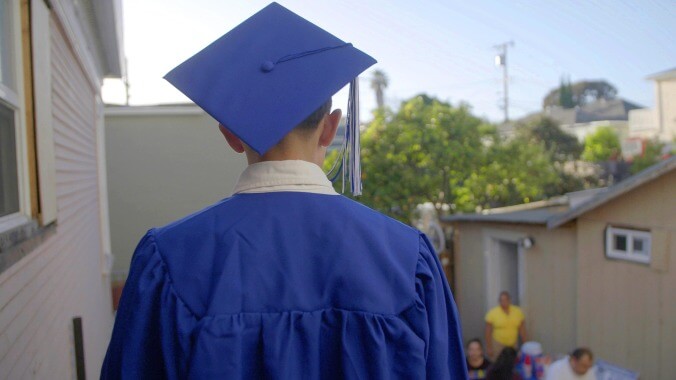Hulu’s Homeroom is a fascinating snapshot of teen advocacy on the cusp of a pandemic
Shot in late 2019 and early 2020, the documentary follows politically involved students at an Oakland high school
Film Reviews Homeroom

Serendipity deserves a writing credit in director Peter Nicks’ documentary Homeroom, which chronicles the 2019-2020 academic year at Oakland High School. Had the world not gone into extreme turmoil before the seniors could graduate, the film would still look plenty relevant as a portrait of youth organizing to defund school police. Nicks’ interest in this particular institution derives from its fraught relationship with cops; his previous nonfiction feature, The Force, followed Bay Area officers as their department was confronted about its history of brutality. Yet the filmmaker couldn’t have anticipated how the pandemic would remold this story or how it would eventually dovetail into the mass protests following the murder of George Floyd.
Among the many teens that pass Nicks’ frame, the main subject and chosen protagonist is Denilson Garibo, an outspoken Latino student director who represents tens of thousands of youths in the Oakland district alongside fellow leader Mica Smith-Dahl. They sit on the adult board to voice the majority’s demands: no policing on campus and more resources to guide marginalized members of the community to higher education. Garibo’s power of persuasion and resolute progressive activism calls to mind Steven Garza, the hero in last year’s doc Boys State about young men in Texas putting the electoral system to the test in a simulacrum of bipartisanship. Paired, these two works on politically minded adolescents act as a double feature balancing out despair and hope about the future leaders of this country. In Homeroom, however, the outcomes of their advocacy aren’t hypothetical.
Nicks and cinematographer Sean Havey operate in a strictly observational but kinetic mode here. There are no interviews and there’s no informational text, only the vibrant cacophony of kids interacting; one minute, we’re watching two boys casually discuss gentrification, the next the film is jumping to more quotidian footage of hallways and cafeterias. Instagram and TikTok videos, inextricable components of modern teen life, are interspersed throughout in all their vertical glory to further a sense of community beyond the school walls. These choreographed dances or inconsequential posts fit the scattered visual grammar of the movie. While Homeroom is far more contained in length and scope than a Frederick Wiseman opus, the way editors Rebecca Adorno and Kristina Motwani construct a narrative from a seemingly free-flowing assembly produces a similarly immersive viewing experience, as if one was wandering the school shrouded in an invisibility cloak.
As spontaneous as the filmmaking appears, Nicks organizes Homeroom around the public sessions where Garibo and Smith-Dahl clash with adults in power unwilling to consider a future without law enforcement in its current form. Divisions of generation, class, and race (the majority of the student body are people of color) are repeatedly verbalized. When an officer attempts to mount some “not all police” copaganda, a young Black woman schools him on how triggering their mere presence is for a lot of students. Homeroom reaches its emotional peak when Garibo brings up his own immigration status and his undocumented family’s vulnerable position. With the threat of homeland security present at public demonstrations, he’s conflicted on how much to personally risk in order to support the cause.
Two thirds in, school closures and lockdowns force the film to transition to zoom meetings and even more social media content. Watching the final days of perceived normalcy from our vantage point, a year and a half into this new reality, feels foreboding. The loss of a conventionally eventful senior year, of the school production of In The Heights that never came to pass, of caps and gowns worn in isolation inside living rooms and backyards, of goodbye hugs not given and celebrations not enjoyed, weighs heavily on the final act. But what’s more encouraging is that Nicks captured a diverse group of people in the early days of their society-changing endeavors—all of whom, at their young age, already grasp the intersectional nature of their plight.
Nevertheless, since the focus is on the leaders of their movement, the voice of those who don’t have nearly as much figured out yet seems missing. Seldom are students less familiar with the dynamics of school government active participants. One not-exactly-prominent exception is a Mexican-American young man who relies on spoken word poetry, written in English and Spanish, to address personal hardship and the invaluable power of acquired knowledge. Avoiding paternalistic judgment, Nicks makes no efforts to sanitize the reality of underage drinking and any other activities that, in the eyes of adversaries, could delegitimize Garibo and company’s efforts. Neither does he show their parents or teachers outside of a few background cameos—a choice that grants the students an autonomy, at least on screen. With Homeroom, he’s made a galvanizing portrait of how Americans inching closer to adulthood navigate a reality in perpetual distress, asserting their agency and fighting with the might of their well informed convictions and digital interconnectivity.